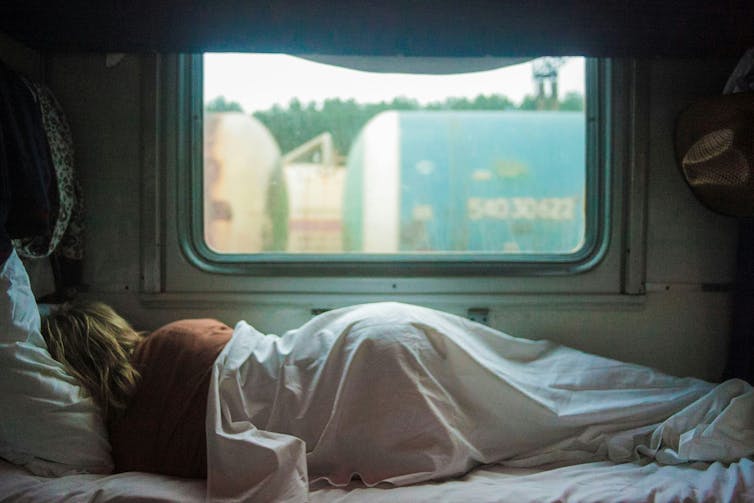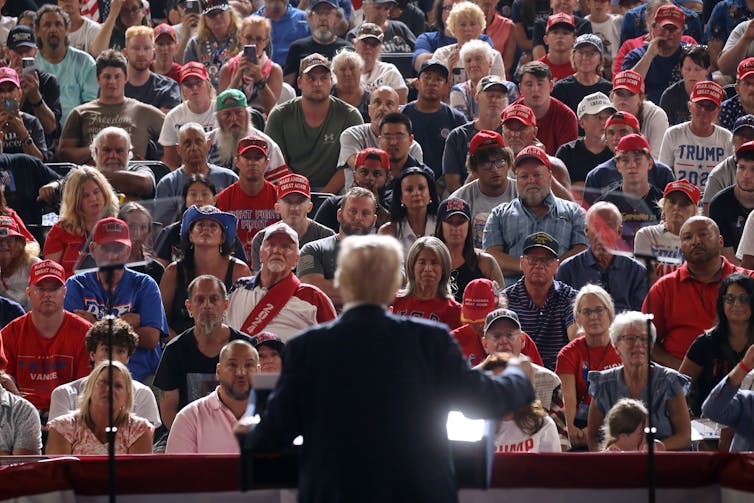In his sci-fi film Inception (2010), Christophe Nolan imagined his protagonist slipping into other people’s dreams and even shaping their contents. But what if this story wasn’t so far away from real life?
Our research suggests that it is possible to interact with volunteers while they are asleep, and even to converse with them at certain key moments.
The scientific study of dreams
While we sometimes wake up with vivid memories from our nocturnal adventures, at others the impression of a dreamless night prevails.
Research shows we remember on average one to three dreams per week. However, not everyone is equal when it comes to recalling dreams. People who say they never dream make up around 2.7 to 6.5% of the population. Often, these people used to recall their dreams when they were children. The proportion of people who say they have never dreamt in their entire life is very low: 0.38%.
Whether people remember their dreams depends on many factors such as gender (women remember their dreams more frequently than men), one’s interest in dreams, as well as the way dreams are collected (some might find it handy to keep track of them with a “dream journal” or a recorder, for example).
The private and fleeting nature of dreams makes it tricky for scientists to capture them. Nowadays, however, thanks to knowledge acquired in the field of neuroscience, it is possible to classify a person’s state of alertness by analysing their brain activity, muscle tone and eye movements. Scientists can thus determine whether a person is asleep, and what stage of sleep they are in: sleep onset, light slow wave sleep, deep slow wave sleep or rapid eye movement (REM) sleep.
What this physiological data does not do is tell us whether a sleeper is dreaming (dreams can occur in all stages of sleep), let alone what they’re dreaming about. Researchers don’t have access to the dream experience as it happens. They are therefore forced to rely on the dreamer’s account upon waking, with no guarantee that this account is faithful to what happened in the sleeper’s head.

Moreover, to understand what happens in the brain while dreaming – and what purpose this activity serves – we would need to be able to compare brain activity during times when dreams occur with those when they are absent. It is therefore imperative to determine precisely when dreams occur in order to further the science of dreams.
To achieve this, it would be ideal to be able to communicate with sleepers. Impossible? Not for everyone - that’s where lucid dreamers come in.
Lucid dreaming
Most of us only realise we’ve been dreaming upon waking. Lucid dreamers, on the other hand, have the unique ability to remain aware of the dreaming process during REM sleep, a stage of sleep during which brain activity is closer to that of the waking phase.
Even more surprisingly, lucid dreamers can sometimes exercise partial control over their dream’s narrative. They are then able to fly away, make people appear or disappear, change the weather or transform themselves into animals. In short, the possibilities are endless.
Such lucid dreams can occur spontaneously or be engineered by specific training. The existence of lucid dreaming has been known since ancient times, but for a long time it was considered esoteric and unworthy of scientific exploration.
Such views have changed thanks to a clever experiment set up by psychologist Keith Hearne and psychophysiologist Stephen Laberge in the 1980s. These two researchers set out to prove that lucid dreamers were indeed asleep when they realised they were dreaming. Departing from the observation that REM sleep is characterised by rapid eye movements while one’s eyes are shut (hence the name ‘Rapid Eye Movement sleep’), they asked themselves the following question: would it be possible to use this property to ask the sleeper to send a “telegram” from their dream to the world around them?
Hearne and Laberge recruited lucid dreamers to try to find out. They agreed with them before they fell asleep on the telegram to be sent: the participants would have to make specific eye movements, such as moving their gaze from left to right three times, as soon as they became aware that they were dreaming. And while they were objectively in REM sleep, the lucid dreamers did just that.
The new communication code allowed researchers from then on to detect dreaming stages in real time. The work paved the way for many research projects in which lucid dreamers act as undercover agents in the dream world, carrying out missions (such as holding one’s breath in a dream) and signalling them to the experimenters using the eye code.
It is now possible to combine such experiments with brain imaging techniques to study the brain regions involved in lucid dreaming. This represents a huge step forward in the quest for a better understanding of dreams and how they are formed.
In 2021, almost 40 years after the pioneering work of Hearne and Laberge, our study in collaboration with academics from around the world has taken us even further.
From fiction to reality: talking to the dreamer
We already knew that lucid dreamers were capable of sending information from their dreams. But can they also receive it? In other words, is it possible to talk to a lucid dreamer? To find out, we exposed a lucid dreamer to tactile stimuli while he was asleep. We also asked him closed questions such as “Do you like chocolate?”.
He was able to respond by smiling to indicate “Yes” and by frowning to indicate “No”. Lucid dreamers were also presented with simple mathematical equations verbally. They were able to provide appropriate answers while remaining asleep.
Of course, lucid dreamers didn’t always respond, far from it. But the fact that they sometimes did (18% of cases in our study) opened a communication channel between experimenters and dreamers.
However, lucid dreaming remains a rare phenomenon and even lucid dreamers are not lucid all the time or throughout REM sleep. Was the communication portal we had opened limited to “lucid” REM sleep alone? To find out, we undertook further work.
Expanding the communication portal
To find out whether we could communicate in the same way with any sleeper, whatever their stage of sleep, we conducted experiments with non-lucid dreaming volunteers without sleeping disorders, as well as with people suffering from narcolepsy. This disease, which causes involuntary sleep, sleep paralysis and an early onset of the REM phase, is associated with an increased propensity for lucid dreaming.
In our latest experiment, we presented participants with existing words (e.g. “pizza”) and others that we made up (e.g. “ditza”) across all sleep stages. We asked them to smile or frown to signal whether the word had been made up or not. Unsurprisingly, people with narcolepsy were able to respond when they were lucid in REM sleep, confirming our results from 2021.
More surprisingly, both groups of participants were also able to respond to our verbal stimuli in most stages of sleep, even in the absence of lucid dreaming. The volunteers were able to respond intermittently, as if windows of connection with the outside world were opening temporarily at certain precise moments.
We were even able to determine the composition of brain activity conducive to these moments of openness to the outside world. By analysing it before the stimuli were presented, we were able to predict whether the sleepers would respond or not.
Why do such windows of connection with the outside world exist? We can put forward the hypothesis that the brain developed in a context where a minimum of cognitive processing was necessary during sleep. We can imagine, for example, that our ancestors had to remain attentive to external stimuli while they were asleep, in case a predator approached. Similarly, we know that a mother’s brain reacts preferentially to her baby’s cries during sleep.
Our results suggest that it is now possible to “talk” to any sleeper, whatever stage of sleep they are in. By refining the brain markers that predict the moments of connection with the outside world, it should be possible to further optimise communication protocols in the future.
This breakthrough paves the way for real-time dialogue with sleepers, offering researchers the chance to explore the mysteries of dreams as they happen. But if the line between science fiction and reality is getting thinner, rest assured: neuroscientists are still a long way from being able to decipher your wildest fantasies.![]()
Başak Türker, Chercheuse postdoctorale, Institut du Cerveau (ICM) et Delphine Oudiette, Chercheure en neurosciences cognitives, Inserm


















